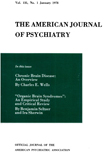Abstract
As part of a larger study of the relations among the primary symptoms of schizophrenia, this report is concerned with the attention disturbance. A reaction time technique employing 2 procedures, a regular and an irregular, was used to measure attention. In the regular procedure the length of the preparatory interval, that is, the time between a visual warning signal and an auditory reaction stimulus, was constant for all reactions to that interval. In the irregular procedure the length of the preparatory interval was varied randomly. Three intervals were used: 2, 5, and 10 seconds. This technique was applied to 4 groups of patients: 22 chronic schizophrenic, 20 early schizophrenic, 21 manic-depressive, depressive type, and 21 neurotic. All patients were tested without and with intravenous sodium amytal and amphetamine sulfate. Amytal alters the primary symptoms in many cases of schizophrenia.
The main results of the experiment were as follows:
1. Without drugs the chronic schizophrenic group was significantly slower in reaction time than the other 3 groups, and the neurotic group significantly faster, while the early schizophrenic and depressive groups were intermediate. With drugs the reaction time of the schizophrenic and neurotic groups slowed; that of the depressive group speeded.
2. Reaction times on the regular procedure were significantly faster than on the irregular for all groups at all preparatory intervals both with and without drugs, with the single exception of the 10-second interval without drugs for the chronic schizophrenic group. Here the reaction times on the regular and irregular were about the same. Under drugs, however, the chronic schizophrenic group also had significantly faster reaction times on the regular procedure at all intervals, including the 10-second.
3. An analysis of the percentage of patients who had the regular procedure faster than the irregular showed that without drugs the highest percentage was in the neurotic group and the lowest in the chronic schizophrenic group. Without drugs, as length of preparatory interval increased, the percentage of patients having the regular faster than the irregular declined; this was marked in the chronic schizophrenic group. Under drugs, in contrast, the percentage of patients who had the regular faster than the irregular was approximately the same for all diagnostic groups at each preparatory interval.
4. A "set index" of attention, based on the relation between the regular and irregular procedures, level of performance, and variability, without drugs, differentiated the chronic schizophrenic patients almost perfectly from the neurotic patients. Under drugs the set index of the chronic group showed a degree of improvement approaching significance.
5. An analysis of factors possibly related to the results indicated a slight correlation between cooperation and set index, changes in cooperation and changes in set index with drugs; and in the combined schizophrenic groups between duration of illness and set index. No relation was found between duration of illness and the separation of procedures, nor between schizophrenic subtype and the separation of procedures or set index.
From these results we conclude: (A) Level of attention is best in the neurotic group, poorest in the chronic schizophrenic group, with the early schizophrenic and depressive groups falling between. (B) Intravenous sodium amytal and amphetamine sulfate have a differential effect, improving the level of attention in depressive patients and making it poorer in the other 3 groups. Whether the explanation of this difference is primarily physiologic or psychologic requires further investigation. (C) Having the regular procedure slower than the irregular on long preparatory intervals is a more prominent characteristic of schizophrenia and especially of chronic schizophrenia than of depression or neurosis. Hence, schizophrenic patients, and especially chronic schizophrenic, have more difficulty maintaining a level of attention than depressive and neurotic patients. (D) Intravenous sodium amytal and amphetamine sulfate improved the ability of chronic schizophrenic patients to maintain a level of attention, as measured by the relation of the regular and irregular procedures. On a more complex measure of attention, the set index, schizophrenic patients showed some, but not significant, improvement with drugs. Hence the disturbance in attention in schizophrenia is not a unitary characteristic but has several aspects.

